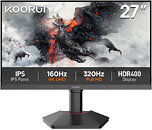KOORUI Launches Multi-Model Monitor Lineup Globally
KOORUI, a global monitor brand backed by HKC's panel expertise, has announced the global release of five new monitors: G2741L, G2411P, 34E6UC, 27E6CA, and E2412F. The launch spans a wide range of use cases—from high-refresh-rate gaming to immersive work displays and affordable everyday options—demonstrating KOORUI's ongoing effort to serve the evolving needs of users around the world.
This new lineup reflects a thoughtful approach to product design. The G2411P cater to gamers with smooth 200 Hz performance and vibrant visuals. The 34E6UC and 27E6CA feature curved displays and wide formats for enhanced productivity, while the slim and practical E2412F offers a reliable solution for efficient office work.
This new lineup reflects a thoughtful approach to product design. The G2411P cater to gamers with smooth 200 Hz performance and vibrant visuals. The 34E6UC and 27E6CA feature curved displays and wide formats for enhanced productivity, while the slim and practical E2412F offers a reliable solution for efficient office work.































